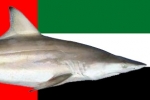North Pacific warming shifts the juvenile range of white sharks
North Pacific warming shifts the juvenile range of a marine apex predator Kisei R. Tanaka, Kyle S. Van Houtan, Eric Mailander, Beatriz S. Dias, Carol Galginaitis, John O’Sullivan, Christopher G. Lowe, Salvador J. Jorgensen ABSTRACT: During the 2014–2016 North Pacific marine heatwave, unprecedented sightings of juvenile white sharks (Carcharodon carcharias) emerged in central California. These
UAE: Seasonal Ban on Shark Fishing and Trade
Press Release United Arab EmiratesMinistry of Climate Change and Environment 24. February 2021 — — — — — — — — Ministry of Climate Change and Environment to Commence Seasonal Ban on Shark Fishing, Trade on March 1 The Ministry of Climate Change and Environment (MOCCAE) will impose the annual fishing and trade ban on
Quantifying the unreported and unaccounted domestic and foreign commercial catch of sharks and rays in Western Australia
Quantifying the unreported and unaccounted domestic and foreign commercial catch of sharks and rays in Western Australia Matias Braccini, Mervi Kangas, Vanessa Jaiteh, Stephen Newman ABSTRACT: Reliable catch information is scarce for most sharks and rays worldwide, with almost half of the stocks considered to be Data Deficient due to limited species-specific catch statistics. Western
Boosted regression tree models predict the diets of juvenile bull sharks
Boosted regression tree models predict the diets of juvenile bull sharks in a subtropical estuary Emy Cottrant, Philip Matich, Mark R. Fisher ABSTRACT: Understanding diet flexibility is important for resource management as climate change alters ecological communities. However, food web complexity often limits our ability to predict how changes in prey communities may alter predator
Using fisher‐contributed secondary fins to fill critical shark‐fisheries data gaps
Using fisher‐contributed secondary fins to fill critical shark‐fisheries data gaps Jessica R. Quinlan, Shannon J. O’Leary, Andrew T. Fields, Martin Benavides, Emily Stumpf, Ramon Carcamo, Joel Cruz, Derrick Lewis, Beverly Wade, George Amato, Sergios‐Orestis Kolokotronis, Gina M. Clementi, Demian D. Chapman ABSTRACT: Developing‐world shark fisheries are typically not assessed or actively managed for sustainability; one
Identifying nearshore nursery habitats for sharks in the Eastern Tropical Pacific
Identifying nearshore nursery habitats for sharks in the Eastern Tropical Pacific from fisheries landings and interviews Juliana López-Angarita, Melany Villate, Juan Manuel Díaz, Juan C. Cubillos, Alexander Tilley ABSTRACT: The Eastern Tropical Pacific (ETP) comprising the coasts of Costa Rica, Panama, Colombia and Ecuador, represents an area of high marine biodiversity that supports productive fisheries
Age and growth of tiger shark from Western Australia
Age and growth of tiger shark (Galeocerdo cuvier) from Western Australia Sophia M. Emmons, Brooke M. D’Alberto, Jonathan J. Smart, Colin A. Simpfendorfer ABSTRACT: The tiger shark (Galeocerdo cuvier) is believed to be a fast-growing shark that has shown regional variation in growth. Vertebrae samples were taken from 124 tiger sharks (60 females, 38 males,
Confirmation of Luminescence Ability for the velvet dogfish
A Third Luminous Shark Family: Confirmation of Luminescence Ability for Zameus squamulosus (Squaliformes; Somniosidae) Laurent Duchatelet, Raphaël Marion, Jérôme Mallefet ABSTRACT: Since recently, shark’s bioluminescence has been recorded from two Squaliformes families, the Etmopteridae and Dalatiidae. Pictures of luminescence, light organ morphologies, and physiology of the luminous control have been described for species of the
Elucidating shark diets with DNA metabarcoding from cloacal swabs
Elucidating shark diets with DNA metabarcoding from cloacal swabs Maurits P. M. van Zinnicq Bergmann, Bautisse D. Postaire, Kirk Gastrich, Michael R. Heithaus, Lisa A. Hoopes, Kady Lyons, Yannis P. Papastamatiou, Eric V. C. Schneider, Bradley A. Strickland, Brendan S. Talwar, Demian D. Chapman, Judith Bakker ABSTACT: Animal dietary information provides the foundation for understanding
Movement Patterns and Habitat Use of Juvenile Porbeagles
Horizontal and Vertical Movement Patterns and Habitat Use of Juvenile Porbeagles (Lamna nasus) in the Western North Atlantic Gregory Skomal, Heather Marshall, Benjamin Galuardi, Lisa Natanson, Camrin D. Braun, Diego Bernal ABSTRACT: The porbeagle (Lamna nasus) is a large, highly migratory endothermic shark broadly distributed in the higher latitudes of the Atlantic, South Pacific, and
Reproductive aspects of seven threatened shark species
Reproductive aspects of seven threatened shark species captured by artisanal fisheries in the southern Caribbean Sea A. Tagliafico, M.S. Rangel, N.R. Ehemann, N.E. Rago, M.K. Broadhurst ABSTRACT: Venezuela is among the top four Latin American countries with the greatest elasmobranch biodiversity. The country is also characterised by extensive artisanal fisheries, but there is a paucity
Possible causes of a substantial decline in white shark sightings in South Africa
Possible causes of a substantial decline in sightings in South Africa of an ecologically important apex predator, the white shark Robin Fisher ABSTRACT: A decline in sightings of a top predator, the white shark (Carcharadon carcharias), in South Africa was quantified in order to identify possible causes for this decline. White shark sightings data across
First complete description of the dark-mouth skate from Antarctic waters
First complete description of the dark-mouth skate Raja arctowskii Dollo, 1904 from Antarctic waters, assigned to the genus Bathyraja (Elasmobranchii, Rajiformes, Arhynchobatidae) Matthias F. W. Stehmann, Simon Weigmann, Gavin J. P. Naylor ABSTRACT: The dark-mouth skate, Raja arctowskii Dollo, 1904 from Antarctic waters is an extraordinary case in skate taxonomy. For more than 100 years,
Morphometric description and biological notes on the kifetin shark
Morphometric description and biological notes on the rare kifetin shark Dalatias licha (Chondrichthyes: Dalatidae) from the Hellenic waters Vasiliki Kousteni ABSTRACT: Deep‐sea sharks are among the less studied and most endangered elasmobranchs existing in the Mediterranean Sea, and thus scientific research should be prioritized towards this vulnerable group of species. The aim of the present
Half a century of global decline in oceanic sharks and rays
Half a century of global decline in oceanic sharks and rays Nathan Pacoureau, Cassandra L. Rigby, Peter M. Kyne, Richard B. Sherley, Henning Winker, John K. Carlson, Sonja V. Fordham, Rodrigo Barreto, Daniel Fernando, Malcolm P. Francis, Rima W. Jabado, Katelyn B. Herman, Kwang-Ming Liu, Andrea D. Marshall, Riley A. Pollom, Evgeny V. Romanov, Colin




